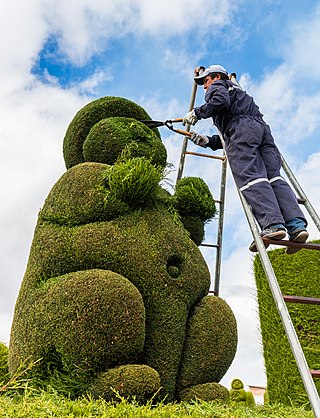
Gardening is the process of growing plants for their vegetables, fruits, flowers, herbs, and appearances within a designated space. Gardens fulfill a wide assortment of purposes, notably the production of aesthetically pleasing areas, medicines, cosmetics, dyes, foods, poisons, wildlife habitats, and saleable goods. People often partake in gardening for its therapeutic, health, educational, cultural, philosophical, environmental, and religious benefits.

Raised-bed gardening is a form of gardening in which the soil is raised above ground level and usually enclosed in some way. Raised bed structures can be made of wood, rock, concrete or other materials, and can be of any size or shape. The soil is usually enriched with compost.

Forest gardening is a low-maintenance, sustainable, plant-based food production and agroforestry system based on woodland ecosystems, incorporating fruit and nut trees, shrubs, herbs, vines and perennial vegetables which have yields directly useful to humans. Making use of companion planting, these can be intermixed to grow in a succession of layers to build a woodland habitat. Forest gardening is a prehistoric method of securing food in tropical areas. In the 1980s, Robert Hart coined the term "forest gardening" after adapting the principles and applying them to temperate climates.
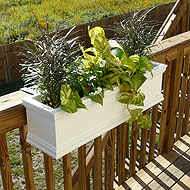
A flower box is a type of container in the form of a planter or box that is usually placed outdoors and used for displaying live plants and flowers, but it may also be used for growing herbs or other edible plants.
Uran gardening is the practice of growing vegetables, fruit and plants in urban areas, such as schools, backyards or apartment balconies.
This is an alphabetical index of articles related to gardening.

A window box is a type of flower container for live flowers or plants in the form of a box attached on or just below the sill of a window. It may also be used for growing herbs or other edible plants.
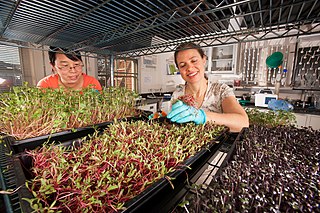
Microgreens are vegetable greens harvested just after the cotyledon leaves have developed with one set of true leaves. They are used as a visual, flavor and texture enhancement. Microgreens are used to add sweetness and spiciness to foods. Microgreens are smaller than "baby greens" because they are harvested soon after sprouting, rather than after the plant has matured to produce multiple leaves.

A flowerpot, planter, planterette or plant pot, is a container in which flowers and other plants are cultivated and displayed. Historically, and still to a significant extent today, they are made from plain terracotta with no ceramic glaze, with a round shape, tapering inwards. Flowerpots are now often also made from plastic, metal, wood, stone, or sometimes biodegradable material. An example of biodegradable pots are ones made of heavy brown paper, cardboard, or peat moss in which young plants for transplanting are grown.

The traditional kitchen garden, vegetable garden, also known as a potager or in Scotland a kailyaird, is a space separate from the rest of the residential garden – the ornamental plants and lawn areas. It is used for growing edible plants and often some medicinal plants, especially historically. The plants are grown for domestic use; though some seasonal surpluses are given away or sold, a commercial operation growing a variety of vegetables is more commonly termed a market garden. The kitchen garden is different not only in its history, but also its functional design. It differs from an allotment in that a kitchen garden is on private land attached or very close to the dwelling. It is regarded as essential that the kitchen garden could be quickly accessed by the cook.

Urban horticulture is the science and study of the growing plants in an urban environment. It focuses on the functional use of horticulture so as to maintain and improve the surrounding urban area. Urban horticulture has seen an increase in attention with the global trend of urbanization and works to study the harvest, aesthetic, architectural, recreational and psychological purposes and effects of plants in urban environments.

Jardinière is a French word, from the feminine form of "gardener". In English it means a decorative flower box or "planter", a receptacle or a stand upon which, or into which, plants may be placed, usually indoors. The French themselves mostly refer to tabletop "planter" versions of such receptacles as cachepots ("hide-pots"). The French tend to use jardinière for larger outdoor containers for plants, and for raised beds in gardens in some sort of isolated frame, such as a stone wall, especially growing vegetables and herbs.
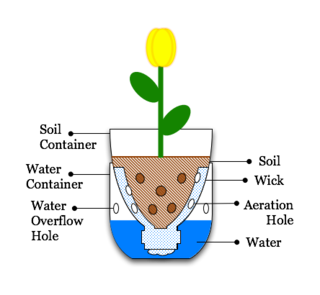
Sub-irrigated planter (SIP) is a generic name for a special type of planting box used in container gardening and commercial landscaping. A SIP is any method of watering plants where the water is introduced from the bottom, allowing the water to soak upwards to the plant through capillary action. It is possible to automate the watering and thus SIPs are popular with professional landscapers in buildings or urban settings. Commercialized versions of a Sub-irrigated planter condenses humidity from the environment and feed it directly into the plants' roots. SIPs are available as commercial products or as do-it-yourself projects made from plastic buckets, boxes or storage totes. One of the disadvantages of such closed systems is that soluble salts cannot be flushed into the lower soil profile and build up over time.
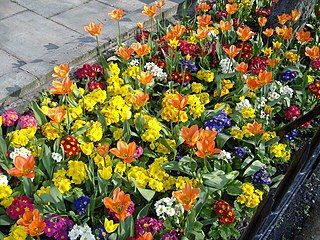
Many types of flowering plants are available to plant in flower gardens or flower beds. The floral industry calls these plants, bedding plants. These fast-growing plants in seasonal flower beds create colourful displays, during spring, summer, fall or winter, depending on the climate. Plants used for bedding are generally annuals, but biennials, tender perennials, and succulents are used.
The Rooftop Garden Project is an experimental urban gardening project in Montreal, Canada.
There are many ways to garden in restricted spaces. Often a small or limited space is an issue in growing and cultivating plants. Restricted space gardens can be located on small lawns, balconies, patios, porches, rooftops, inside the home, or in any other available place. Gardening in small places can be applied to edible or floral plants. Growing food has many benefits including saving money; healthier, fresher, and better tasting food; knowledge of pesticide and fertilizer exposure. Gardening is a good form of exercise and has been proven to be therapeutic.

Micro-irrigation, also called Micro-spray,localized, low-volume, low-flow, or trickle irrigation, is an irrigation method with lower water pressure and flow than a traditional sprinkler system. Low-volume irrigation is used in agriculture for row crops, orchards, and vineyards. It is also used in horticulture in wholesale nurseries, in landscaping for civic, commercial, and private landscapes and gardens, and in the science and practice of restoration ecology and environmental remediation. The lower volume allows the water to be absorbed into slow-percolation soils such as clay, minimizing runoff.

Foodscaping is a modern term for the practice of integrating edible plants into ornamental landscapes. It is also referred to as edible landscaping and has been described as a crossbreed between landscaping and farming. As an ideology, foodscaping aims to show that edible plants are not only consumable but can also be appreciated for their aesthetic qualities. Foodscaping spaces are seen as multi-functional landscapes which are visually attractive and also provide edible returns. Foodscaping is a great way to provide fresh food in an affordable way.
Click and Grow is an Estonian indoor gardening company, founded by Mattias Lepp in 2009. It develops consumer electronic products for growing edible plants indoors.


















